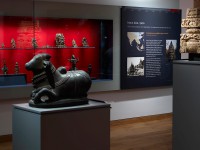Room 32 | India 600-1900 gallery
Explore Hindu, Buddhist and Jain art from India, the Himalayas and Southeast Asia.

From AD 600 onwards, many regional kingdoms flourished across north and central India, from Kashmir in the north-west to Uttar Pradesh in the east. Most of the ruling dynasties favoured Hinduism and were active patrons of temple architecture and sculpture. Jainism also became well established in Gujarat and Rajasthan in the west.
During this period a wide variety of styles of sculpture arose, as can be seen below. All derived in some degree from the classic Gupta tradition (AD 300-500), though with distinct regional variations. New and more complex images of the deities were also developed. This period of creativity lasted until around 1200 when Muslim invaders from Central Asia began to occupy northern India.
Kashmir and the northwest
 Figure of Shiva the Great Lord (EA2013.69)
Figure of Shiva the Great Lord (EA2013.69)
 Figure of Brahma, god of creation (EA1995.114)
Figure of Brahma, god of creation (EA1995.114)
 Head of Shiva as an ascetic (EA1995.91)
Head of Shiva as an ascetic (EA1995.91)
 Head of Narasimha Avatar (EA2013.68)
Head of Narasimha Avatar (EA2013.68)
 Figure of Surya, the Sun god (EA1986.2)
Figure of Surya, the Sun god (EA1986.2)
 Shivalinga (EA2013.91)
Shivalinga (EA2013.91)
 Figure of Vishnu with two attendant figures (EA1995.90)
Figure of Vishnu with two attendant figures (EA1995.90)
 Stone plaque of Narasimha slaying the demon Hiranyakashipu (EA1996.78)
Stone plaque of Narasimha slaying the demon Hiranyakashipu (EA1996.78)
 Figure of Ganesha (EA2013.73)
Figure of Ganesha (EA2013.73)
 Figure of Parvati (EA2013.90)
Figure of Parvati (EA2013.90)
 Figure of Narasimha eviscerating Hiranyakashipu (EA2013.92)
Figure of Narasimha eviscerating Hiranyakashipu (EA2013.92)
 Figure of Shiva (EA2013.89)
Figure of Shiva (EA2013.89)
 Durga slays the Buffalo-demon (EAOS.64)
Durga slays the Buffalo-demon (EAOS.64)
 Head of Vishnu (EA1995.73)
Head of Vishnu (EA1995.73)
 Head of a Tirthankara, or Jain saviour (EAX.245)
Head of a Tirthankara, or Jain saviour (EAX.245)
 Figure of Maitreya, the future Buddha (EA1995.165)
Figure of Maitreya, the future Buddha (EA1995.165)
 Seated figure of Padmapani (EA1971.14)
Seated figure of Padmapani (EA1971.14)
 Standing figure of Padmapani (EA2013.65)
Standing figure of Padmapani (EA2013.65)
 Figure of Tara, goddess of protection (EA2013.67)
Figure of Tara, goddess of protection (EA2013.67)
 Figure of Tara seated on lion throne (EA1997.200)
Figure of Tara seated on lion throne (EA1997.200)
 Seated figure of Tara (EA2013.66)
Seated figure of Tara (EA2013.66)
 Seated figure of Padmapani (EA1996.75)
Seated figure of Padmapani (EA1996.75)
 Seated figure of Padmapani (EA1993.372)
Seated figure of Padmapani (EA1993.372)
 Apsaras, or celestial nymph (EA1998.226)
Apsaras, or celestial nymph (EA1998.226)
 Figure of Padmapani with attendants (EA2013.63)
Figure of Padmapani with attendants (EA2013.63)
Freestanding sculpture
 Figure of Varaha, the Boar incarnation of Vishnu (EA1969.43)
Figure of Varaha, the Boar incarnation of Vishnu (EA1969.43)
 Head of a yogini or goddess (EA1965.41)
Head of a yogini or goddess (EA1965.41)
 Boss from a temple ceiling with circle of flying warriors (EA1985.5)
Boss from a temple ceiling with circle of flying warriors (EA1985.5)
Notice
Objects may have since been removed or replaced from a gallery. Click into an individual object record to confirm whether or not an object is currently on display. Our object location data is usually updated on a monthly basis, so contact the Jameel Study Centre if you are planning to visit the museum to see a particular Eastern Art object.
© 2013 University of Oxford - Ashmolean Museum







